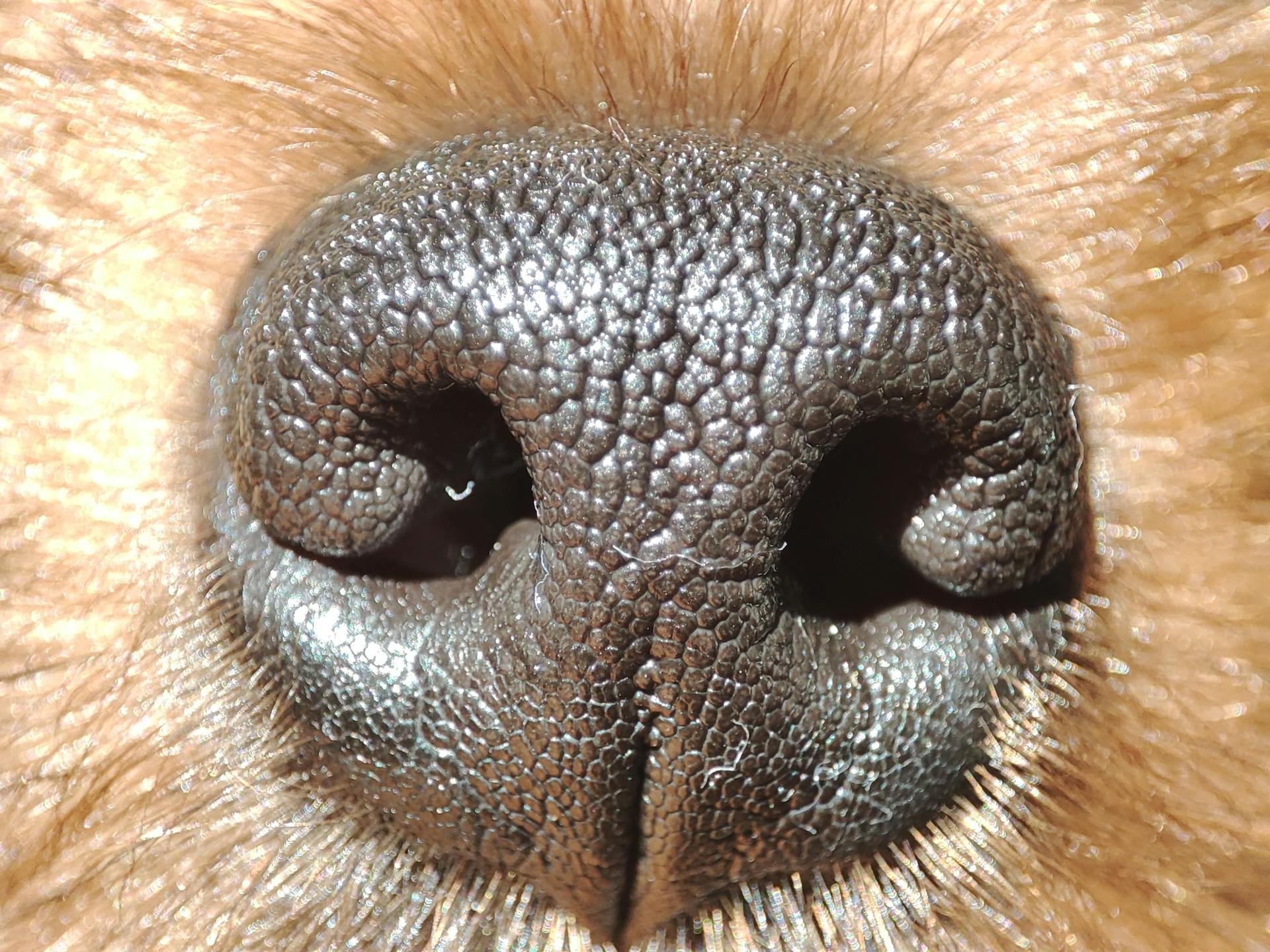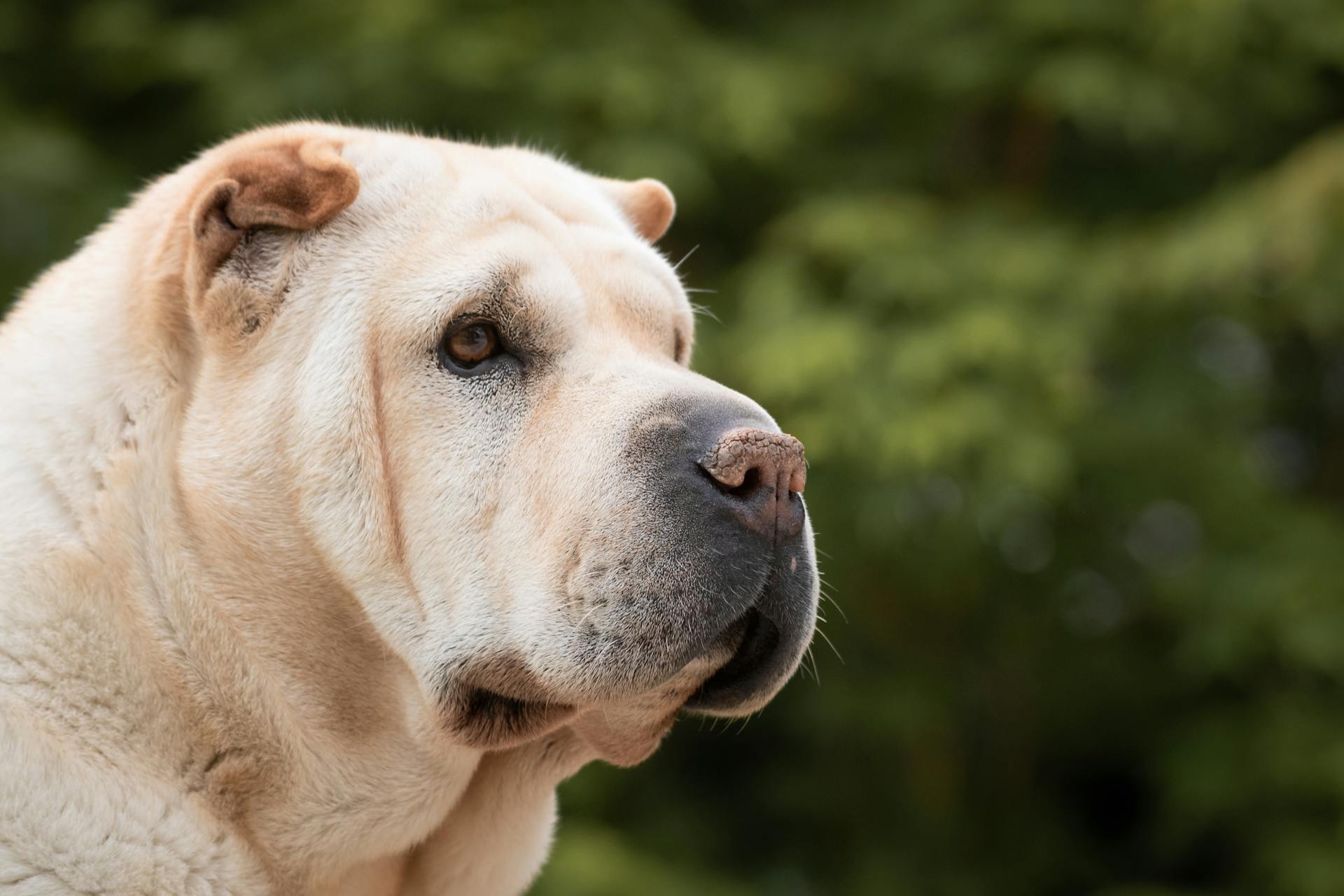
Yeast infections in female dogs are a common issue that can cause discomfort and pain for our furry friends. According to research, yeast infections can occur in up to 20% of dogs.
The main culprit behind female dog yeast infections is a type of fungus called Malassezia, which is naturally found on their skin. However, it can overgrow and cause problems.
Female dogs are more prone to yeast infections due to their anatomy, with the vulva being a warm and moist area that's perfect for yeast to thrive in. This is especially true for dogs with floppy ears, as the moisture can accumulate and create an ideal environment for yeast to grow.
Regular grooming and cleaning can help prevent yeast infections by reducing moisture and preventing the buildup of bacteria.
A different take: Food for Yeast Infection in Dogs
Causes and Symptoms
A female dog yeast infection can be a real challenge to deal with, but understanding the causes and symptoms can help you identify the issue and take action.
The most common causes of yeast infections in dogs, including females, include an underactive or overreactive immune system, allergies to substances like smoke, mold, and dust, and foods high in sugar and carbs.
Heat and humidity can also contribute to yeast growth, as can poor hygiene and trapped moisture in skin folds, ears, or paw pads. Frequent bathing, especially in the ears, and swimming can also increase the risk of a yeast infection.
Some breeds, such as Pit Bulls, Boxers, and Cocker Spaniels, are more prone to yeast infections due to their genetics. Additionally, underlying health conditions or environmental factors can weaken a dog's immune system, making them more susceptible to yeast infections.
Symptoms of a yeast infection in a female dog can vary depending on the affected area, but common signs include itching, redness, and a strong, musty odor. You may also notice a brownish, waxy discharge in the ears, crusty areas or raised spots on the skin, and thickened or darkened skin.
Here are some key symptoms to look out for:
- Itching and scratching
- Redness and swelling
- Brownish, waxy discharge in the ears
- Crusty areas or raised spots on the skin
- Thickened or darkened skin
- Strong, musty odor
If you suspect your female dog has a yeast infection, it's essential to consult with a veterinarian for an accurate diagnosis and treatment plan.
Prevention and Treatment
Prevention of yeast infections in dogs is crucial to avoid discomfort and complications for your furry friend. Regular ear cleaning with a clean cloth or cotton ball can help prevent yeast infections in the ear canal.
Feeding your dog a healthy diet full of protein and other nutrients can also help prevent yeast infections. Brushing your dog often as part of their regular hygiene routine can clear away dead skin and dirt, reducing the risk of infection.
Completely drying your dog after a bath or playing in the water is essential to prevent yeast infections. Your veterinarian can also recommend special cleansers and ear-drying solutions that can be used at home to help prevent chronic infections.
Here are some ways to prevent yeast infections in dogs:
- Completely drying your pup after a bath or playing in the water
- Cleaning your dog's ears of dirt regularly with a clean cloth or cotton ball
- Feed your pooch a healthy diet full of protein and other nutrients
- Brush your dog often as part of their regular hygiene routine to clear away dead skin and dirt
Regular preventive care and vaccinations can also help keep your dog healthy and less likely to develop infections. Your veterinarian can catch and manage health conditions that can lead to yeast infections early during routine wellness visits.
Readers also liked: Yeast Infections
Prevention

Regularly checking your dog's ears for discharge, odor, and swelling can help prevent ear infections. This should be done after your dog bathes or swims, when you can gently dry the outer part of their ears.
Using an ear-cleaning medicine with a drying agent can also be helpful. However, be careful not to insert any objects into the ear canal unless your vet has shown you how to do it safely.
You can also prevent yeast infections by completely drying your pup after a bath or playing in the water, cleaning their ears regularly with a clean cloth or cotton ball, and feeding them a healthy diet full of protein and other nutrients.
Brushing your dog often as part of their regular hygiene routine can also help clear away dead skin and dirt. This can be especially important if your dog has long hair in the opening of their ears, which can be trimmed or tweezed by a groomer or carefully done yourself.
You might enjoy: Why Does My Male Dog Lick My Female Dogs Ear

Some common causes of yeast infections include an underactive or overreactive immune system, allergens, foods high in sugar and carbs, heat and humidity, poor hygiene, and trapped moisture in skin folds, ears, or paw pads.
Here are some tips to help prevent yeast infections and ear infections in dogs:
- Completely dry your pup after a bath or playing in the water
- Clean your dog's ears regularly with a clean cloth or cotton ball
- Feed your dog a healthy diet full of protein and other nutrients
- Brush your dog often as part of their regular hygiene routine
- Regularly check your dog's ears for discharge, odor, and swelling
By following these tips and being aware of the common causes of yeast infections, you can help keep your dog's ears and skin healthy and prevent infections.
Treatment
Treatment of yeast infections in dogs depends on the location and severity of the infection. If the infection affects only one area, a topical medication may be all that is needed.
Topical antifungal ointments or creams, such as miconazole and ketoconazole, can be prescribed by your vet to treat yeast infections of the outer ear canal.
Your vet might recommend a full cleaning of the dog's ear canal, and special cleansers and ear-drying solutions can be used at home for chronic problems.
Intriguing read: Yeast Infection Smell

Antifungal medications, including ointments, shampoos, and oral tablets like ketoconazole, fluconazole, or terbinafine, can be prescribed to treat yeast dermatitis.
If your dog's infection is more serious, your vet may prescribe oral tablets or recommend surgery, such as total ear canal ablation, to treat a yeast infection in the ear that caused deafness.
Treatment for yeast infections in dogs can be a long-term effort, and it's essential to determine the underlying cause of the infection to improve treatment success.
Most dogs start to feel relief from their symptoms in a week or two, but it can take several additional weeks for a pet parent to notice significant improvement to their skin and coat.
Suggestion: Female Dog Prolapse
Types and Diagnosis
Diagnosing a female dog yeast infection can be a multi-step process. Your veterinarian will gather a thorough medical history to understand when symptoms started and if your pet is taking any medications.
A full physical exam will be performed to check your dog's overall health. Blood work may also be done to check for any abnormalities.
Explore further: Does Getting a Female Dog Fixed Calm Her down
To confirm a yeast infection, your veterinarian may use additional tests such as a tape impression, cytology, culture, or skin biopsy. These tests can help identify yeast and determine the type of organism present.
Here are some of the tests your veterinarian may use:
- Tape impression: A piece of clear tape is pressed to the affected area of skin to collect a sample, which is then stained and examined under a microscope.
- Cytology: A cotton swab is used to collect a sample from the affected area, which is then rubbed gently onto a microscope slide and stained.
- Culture: A sterile cotton swab is used to collect a sample from the affected area, which is then sent to a lab to identify the type of organism present.
- Skin biopsy: A small sample of skin can be taken and sent to a lab for a more accurate diagnosis.
Types of
Dogs can develop yeast infections in various parts of their body, including their ears, skin, and paws. These infections can be caused by an overproduction of yeast that normally lives on their skin.
Ear infections, also known as yeast otitis, cause a thick, brown discharge and strong odor in the ear canal. Affected dogs will repeatedly scratch their ears to try to relieve the discomfort and may also shake their heads and develop a head tilt.
Skin infections, also known as yeast dermatitis, refer to a yeast infection anywhere on the skin. Affected dogs have a musty odor, greasy coat, flaky or thickened skin, and hair loss. They tend to lick the affected areas of the body, which leads to brown discoloration of the skin over time.
Worth a look: Why Does My Female Dog Lick My Ears

Paw infections are generally related to environmental allergies, such as allergies to grass or pollen. Dogs constantly chew or lick their itchy paws, which leads to brown discoloration between the paw pads. Over time, open sores can develop on the paws.
Here are the common types of yeast infections in dogs:
- Ear infections (yeast otitis)
- Skin infections (yeast dermatitis)
- Paw infections
These infections can be caused by various factors, including an underactive or overreactive immune system, allergens, foods high in sugar and carbs, heat and humidity, poor hygiene, and trapped moisture in skin folds, ears, or paw pads.
Ringworm
Ringworm is a common fungal infection in dogs, caused by a collection of pathogenic fungi known as dermatophytes.
This infection is extremely contagious and can be spread through direct contact with an infected animal, person, or object. Ringworm can affect a dog's skin, fur, or nails.
Symptoms of ringworm include hair loss, itching, flaky or crusty skin, and misshapen or brittle nails. Early detection and treatment are essential to prevent the spread of ringworm to other household pets or people.
Treatment for ringworm may include medicated baths and dips, oral antifungal medications, and frequent vacuuming and disinfecting of the house.
A unique perspective: What Food Is Good for Dogs Skin and Coat
Frequently Asked Questions
What does yeast look like on a female dog?
Yeast infections on a female dog typically appear as yellowish or greyish flakes, pink and inflamed skin, and crusty areas or raised spots. If left untreated, chronic changes such as thickened or darkened skin may develop.
What kills yeast on dogs?
Yeast on dogs can be killed with 4% chlorhexidine shampoos like ChlorhexiDerm Max, or with other anti-yeast products such as Selsun Blue, Miconazole shampoo, and Nizoral shampoo.
How do I know if my dog has a bacterial or yeast infection?
Look for signs like itchy skin, flaky or crusty patches, redness, inflammation, and a strong odor, which can indicate a bacterial or yeast infection in your dog
How do you get rid of a yeast infection on a female dog?
To treat a yeast infection in a female dog, use topical antifungal medications and steroids to reduce inflammation, and follow your veterinarian's recommendations for medicated ear wash and ear medications. Consult with your veterinarian for a proper diagnosis and treatment plan to resolve the issue.
Can I use Monistat on my female dog?
While Monistat's active ingredient miconazole can be effective against yeast infections, its use on dogs is not a recommended or approved practice, and you should consult a veterinarian for proper treatment. If you suspect a yeast infection in your female dog, a vet can provide guidance on safe and effective treatment options.
Sources
- https://www.webmd.com/pets/dogs/yeast-infection-in-dogs-causes-treatment-and-prevention
- https://www.hillcrestanimals.com/site/blog-memphis-vet/2020/08/18/fungal-infections-in-dogs-causes-symptoms-treatments
- https://www.germantownah.com/site/blog-memphis-vet/2022/03/15/yeast-dog-dermatitis
- https://www.petmd.com/dog/conditions/skin/yeast-infections-dogs
- https://www.vets4pets.com/pet-health-advice/dog-advice/yeast-infections-in-dogs/
Featured Images: pexels.com


